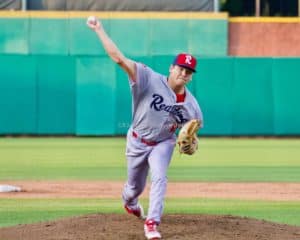

Philadelphia Phillies top pitching prospect Spencer Howard isn’t injured, but both he and the organization had no problem admitting Saturday that there was a minor scare last week.
Howard, a non-roster invitee to major league Spring Training, acknowledged Monday that he did have an MRI last week after landing in an awkward fashion on his right knee while doing a drill in the team’s weight room.
“Just landed kind of funny, but no big deal,” Howard told the collective media, including Jim Salisbury of NBC Sports Philadelphia. “The MRI was all clear.”
“Nothing is like actually injured, just pretty much gives me an excuse to do nothing early.”
New manager Joe Girardi told Salisbury that while Howard hasn’t shown any lingering signs of an injury since the MRI, the Phillies now have an excuse to continue preparing the 23-year-old for the upcoming season in a very gradual manner.
Howard was excellent in 71 regular season innings across three minor league levels a season ago, posting a 2.03 cumulative ERA. Based off of his success a season ago, Eric Longenhagen of FanGraphs ranked Howard as the No. 26 overall prospect in baseball entering the 2020 season.
However, Howard’s workload a season ago was limited because of a right shoulder injury that cost him all of May and most of June. He did pitch seven postseason innings for Double-A and 21.1 innings in the Arizona Fall League, but he still pitched less than 100 total innings in 2019.
While the Phillies may need Howard to make an impact in 2020, they also need to make sure that they don’t increase his innings so much that he gets hurt and it clouds his long-term future. Girardi and Phillies assistant general manager Scott Proefrock told Phillies Nation‘s Ty Daubert in January that Howard could be limited to 140-150 innings “or fewer” in 2020.
General manager Matt Klentak was asked about Howard’s workload earlier this week, and while he didn’t make any mention of the MRI, he was frank in discussing having to balance wanting to see Howard make an impact at the major league level with being sure he could still pitch in the thick of a pennant race.
“We’re not going to disclose a hard limit, but part of the reason for that is that I don’t believe a hard innings limit is the best way to do that. Not every inning is created the same,” Klentak said to the assembled media. “We have a lot of ways to measure fatigue now, whether it’s measuring an arm slot, or velocity – which we have for a long time – but there’s a lot of different technologies that we can use to see when a player is tiring. So we will have some guidelines in terms of innings, pitches, workload and things of that nature, but we don’t want to box ourselves into a hard cap.”
“I think what’s very important, though, is if our season goes as we hope it’s going to go, Spencer Howard is going to hopefully be pitching meaningful innings for this team in the second half of the season…maybe before that… but in the second half of the season. And we need to make sure that he has enough innings or pitches remaining in his season to help us down the stretch. So every pitch that he throws in February is a pitch that he’s not going to be able to throw in September.”
So how do the Phillies avoid a nauseating late-season debate on sports talk radio about a potential innings limit? Probably by greatly limiting how much he throws before the summer. Though Howard said he’s unsure what level he will start the 2020 season at, he told Jim Salisbury of NBC Sports Philadelphia this week that it’s possible he could stay behind after camp breaks and begin the season in extended Spring Training.